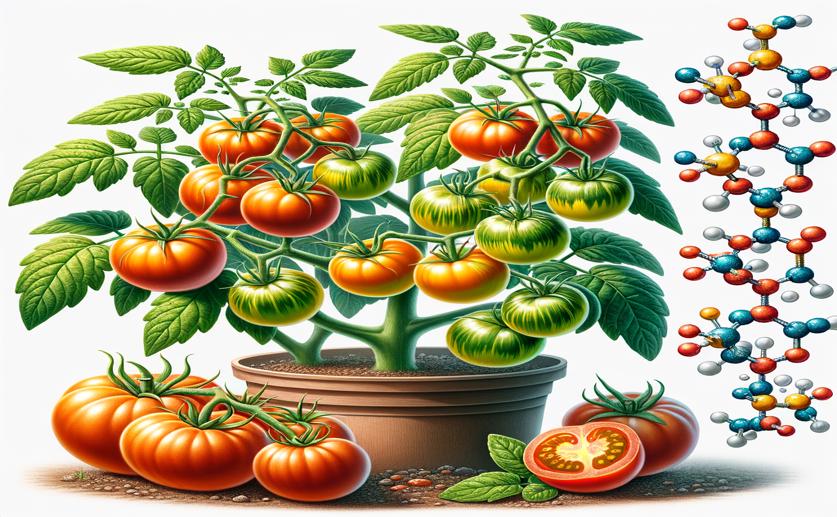Tomato Gene SlNAP1 Controls Ripening Through Growth Hormones

Image Source: Natural Science News, 2024
Key Findings
- Scientists at Gansu Agricultural University found a gene, SlNAP1, that's key to tomato ripening
- Disabling SlNAP1 with CRISPR/Cas9 delayed the tomatoes' color change and ethylene production
- SlNAP1 works with other proteins to control the breakdown of growth hormones, aiding ripening
Tomatoes are a staple in diets worldwide, and understanding how they ripen could have substantial implications for agriculture and food science. At Gansu Agricultural University, scientists have been delving into this process at the genetic level. They've recently made a breakthrough in identifying a key player in the ripening of tomato fruit: a gene called SlNAP1[1]. This gene is part of the NAC family of transcription factors—proteins that help turn genes on or off.
Transcription factors are like switches that control various physiological processes, including the ripening of fruit. Ripening is not just about tomatoes turning red; it involves a complex interplay of texture, flavor, and nutritional content changes. It's a highly coordinated event controlled by the plant's genetic blueprint, which includes a suite of ripening-related genes that need to be activated at the right time.
The study at Gansu Agricultural University employed a cutting-edge gene-editing tool known as CRISPR/Cas9 to investigate the role of SlNAP1. By knocking out this gene in tomato plants, scientists observed a delay in both the production of ethylene—a plant hormone involved in ripening—and the color change that indicates a tomato is ready to eat. This suggests that SlNAP1 is crucial for the timely ripening of tomatoes.
Further experiments using yeast one-hybrid and dual-luciferase reporter assays revealed that SlNAP1 directly binds to and activates the promoters of SlGA2ox1 and SlGA2ox5. These are genes involved in breaking down gibberellins, plant hormones that usually promote growth but must be degraded for fruit to ripen. By activating these genes, SlNAP1 ensures that gibberellins are kept in check, paving the way for ripening to proceed.
Interestingly, SlNAP1 doesn't work alone. Through additional assays, the researchers discovered that SlNAP1 interacts with another protein called SlGID1, which is part of the gibberellin signaling pathway. This interaction hints at a more complex network where SlNAP1 might regulate fruit ripening not just by turning genes on or off but also through its partnerships with other proteins.
This study builds on previous research that has explored different transcription factors involved in tomato ripening. For instance, SlZFP2, another zinc finger transcription factor, was found to repress ABA biosynthesis, an important plant hormone pathway, during fruit development[2]. Meanwhile, SlbHLH22, a basic helix-loop-helix transcription factor, was shown to control flowering time and accelerate fruit ripening, suggesting that multiple transcription factors are at play in these processes[3]. Additionally, research on SNAC4 and SNAC9, also members of the NAC family, demonstrated their role in positively regulating tomato fruit ripening through the ethylene synthesis pathway[4].
The current study not only adds SlNAP1 to the list of transcription factors known to regulate tomato ripening but also provides a novel insight into how it does so through the gibberellin degradation pathway. It ties together the roles of various transcription factors and plant hormones in orchestrating the complex process of fruit ripening.
Understanding these genetic mechanisms is crucial for agriculture. With this knowledge, scientists and farmers can potentially manipulate the ripening process to ensure that tomatoes and other fruits ripen at the most opportune time, improving crop yields, shelf life, and nutritional value. It could lead to tomatoes that last longer on the shelf without losing flavor or nutritional content, benefitting both producers and consumers.
The findings from Gansu Agricultural University not only deepen our understanding of plant biology but also have practical applications in agriculture. By shedding light on the intricate genetic dance that leads to perfectly ripe tomatoes, this research could one day help feed a growing world more efficiently and deliciously.
FruitsBiochemPlant Science
References
Main Study
1) A tomato NAC transcription factor, SlNAP1, directly regulates gibberellin-dependent fruit ripening.
Published 23rd April, 2024
Journal: Cellular & molecular biology letters
Issue: Vol 29, Issue 1, Apr 2024
Related Studies
3) Overexpression of a basic helix-loop-helix transcription factor gene, SlbHLH22, promotes early flowering and accelerates fruit ripening in tomato (Solanum lycopersicum L.).
https://doi.org/10.1007/s00425-019-03157-8
Related Articles





 24th January, 2024 | Phil Stevens
24th January, 2024 | Phil Stevens